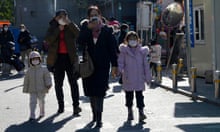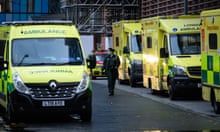Three times as many people are dying of flu this winter in the UK compared with last year, with the death toll since October now at 155, figures show.
Last week there was a big jump in the number of people hospitalised with the virus and further increases in the numbers being treated in critical care units or visiting a GP with flu-like symptoms.
Across the UK last week 35 people died of flu – more than three times the 11 deaths recorded in the corresponding seven days last January. Similarly, the death toll since October is about treble the 53 that occurred in the same period last winter.
The toll is the highest it has been at this stage of winter since 2014-15.
The figures from Public Health England show that what it says is the worst flu outbreak since 2010-11 is affecting fewer adults but leaving growing numbers of children unwell.
But PHE believes the number of people contracting flu has begun to plateau, a picture confirmed by the Royal College of GPs from its separate flu surveillance system.
“We are continuing to see flu circulate. However, rates across most indicators have remained relatively stable and signs are that flu activity is starting to peak,” said Richard Pebody, PHE’s acting head of respiratory diseases.
PHE said it hoped the fact that 1.5 million more people had had the flu jab this winter compared with 2016-17 would help limit the infection’s spread.
Prof Helen Stokes-Lampard, the chair of the RCGP, said: “Influenza rates have levelled out for now. [However] there are still huge numbers of patients being seen in general practice with flu and other common winter conditions – and GPs and our teams are certainly feeling the pressure.”
PHE said the rate of people visiting a GP with influenza-like illness (ILI) crept up last week to 54.1 per 100,000 of population in England, from 53.1 the week before.
It added: “GP consultations for ILI decreased for adults, [but] increases were noted in the five to 14 years age group.”
The number of people calling the NHS 111 telephone helpline or GP out-of-hours services because of flu in children that age underlined that picture, PHE said.
Q&AWhy is the NHS winter crisis so bad in 2017-18?
Show
A combination of factors are at play. Hospitals have fewer beds than last year, so they are less able to deal with the recent, ongoing surge in illness. Last week, for example, the bed occupancy rate at 17 of England’s 153 acute hospital trusts was 98% or more, with the fullest – Walsall healthcare trust – 99.9% occupied.
NHS England admits that the service “has been under sustained pressure [recently because of] high levels of respiratory illness, bed occupancy levels giving limited capacity to deal with demand surges, early indications of increasing flu prevalence and some reports suggesting a rise in the severity of illness among patients arriving at A&Es”.
Many NHS bosses and senior doctors say that the pressure the NHS is under now is the heaviest it has ever been. “We are seeing conditions that people have not experienced in their working lives,” says Dr Taj Hassan, the president of the Royal College of Emergency Medicine.
The unprecedented nature of the measures that NHS bosses have told hospitals to take – including cancelling tens of thousands of operations and outpatient appointments until at least the end of January – underlines the seriousness of the situation facing NHS services, including ambulance crews and GP surgeries.
The RCGP said that, based on its analysis of flu data from surgeries, the rate of people visiting a GP with flu rose in the south of England last week from 54.3 to 59.6 per 100,000 population, and in London from 42.1 to 44.9.
It fell in the north of England from 57.3 to 54.9 per 100,000 population and in the Midlands and east of England from 57.9 to 53.6.
Last week 758 people were admitted to hospital as a result of flu – a big rise on the 598 the week before. However, the number of people ending up in intensive care or a high-dependency unit because of flu went up only slightly, from 198 to 205.
Those figures are based on a sample of 22 trusts – about one-ninth of the total number – and the 205 figure does not represent the full picture of all those admitted to a UK hospital as an emergency because of flu.
The number of flu outbreaks rose last week to 231 from 216, and 163 of those occurred in a care home.
About six in 10 children in England have had a free flu jab this winter, slightly more than last year. Almost two-thirds (63.9%) of frontline healthcare workers have also been immunised, up 2.1% on last year.









